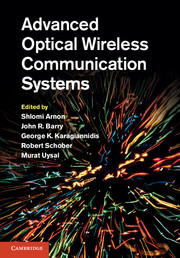Book contents
- Frontmatter
- Contents
- List of contributors
- Part I Outlook
- Part II Optical wireless communication theory
- 2 Coded modulation techniques for optical wireless channels
- 3 Wireless optical CDMA communication systems
- 4 Pointing error statistics
- 5 Equalization and Markov chains in cloud channel
- 6 Multiple-input multiple-output techniques for indoor optical wireless communications
- 7 Channel capacity
- Part III Unique channels
- Part IV Applications
- Index
6 - Multiple-input multiple-output techniques for indoor optical wireless communications
from Part II - Optical wireless communication theory
Published online by Cambridge University Press: 05 June 2012
- Frontmatter
- Contents
- List of contributors
- Part I Outlook
- Part II Optical wireless communication theory
- 2 Coded modulation techniques for optical wireless channels
- 3 Wireless optical CDMA communication systems
- 4 Pointing error statistics
- 5 Equalization and Markov chains in cloud channel
- 6 Multiple-input multiple-output techniques for indoor optical wireless communications
- 7 Channel capacity
- Part III Unique channels
- Part IV Applications
- Index
Summary
The popular adage, “a picture is worth a thousand words” suggests that it is often easier to convey a large amount of information in parallel by way of an image rather than by serial transmission of words. Indeed, this is the underlying inspiration for a new class of indoor optical wireless (OW) channels. In these channels data are conveyed by coordinating the transmission of a series of transmitters and receivers. So called, multiple-input multiple-output (MIMO) OW systems employ a number of optical sources as transmitters and a collection of photodiodes as receivers. The arrangement of emitters and detectors varies depending on application and implementation technology.
The use of MIMO techniques in radio channels is a long-standing topic of interest. It has been shown that by increasing the number of antennae in a radio system that a diversity gain can be achieved, i.e., an improvement in the reliability of the system can be had. Alternatively, it has been demonstrated that multiple transmitting and receiving antennae can be used to provide a boost in rate, i.e. a multiplexing gain. In fact, a formal trade-off between diversity and multiplexing gain in MIMO radio channels has been established [1].
The OW MIMO systems discussed in this chapter differ fundamentally from earlier work on radio channels. In particular, only indoor OW channels are considered here and are free of multipath fading. In addition, the signalling constraints imposed by intensity-modulated/direct-detection (IM/DD) systems limits the direct application of theory from radio channels. Nonetheless, MIMO techniques have been applied to OW channels to yield improvements in reliability and to improve data rates.
- Type
- Chapter
- Information
- Advanced Optical Wireless Communication Systems , pp. 116 - 145Publisher: Cambridge University PressPrint publication year: 2012
- 1
- Cited by



